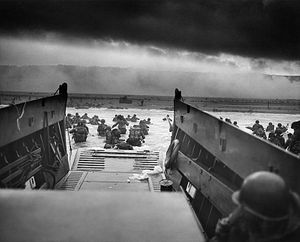On Friday, the world celebrated the 70th anniversary of D-Day, the largest amphibious assault in history consisting of some 160,000 British, American and Canadian troops aided by around 5,000 ships and 13,000 aircraft. Despite the weakened state of the Nazi military by the summer of 1944, as well as poor preparation on Berlin’s part, victory was by no means guaranteed.
Seaborne invasions are one of, if not the most, difficult kind of military operation. That is partially why, as Mearsheimer points out, the great stopping power of water is so consequential in international politics. At first glance, it might seem like the innovations in transportation and communication technology that have triggered globalization would make contemporary amphibious assaults easier
Not so, however. To begin with, many of the basic challenges that have always plagued seaborne invasions are rooted in geography, which remains relatively fixed. Namely, the defending force in amphibious invasions are usually heavily fortified while the landing force typically has to initially fight in the open. The landing force also remains extremely vulnerable before actually reaching land, especially since the defending force can rely on land-based defense systems.
In fact, as Stratfor, a private global intelligence firm, points out, modern defense technologies have made amphibious assaults much more difficult. The most “significant development” since World War II, Stratfor points out, is precision-guided munitions (these did exist in rudimentary form during the conflict). The analysis goes to explain:
“A contemporary landing force would approach the beachhead in an amphibious landing vehicle such as the U.S. Assault Amphibious Vehicle, which moves at around 13 kph (8 mph). This would be vulnerable to anti-tank guided missiles fired from positions onshore. On D-Day, ships in the Allied invasion fleet were also able to come relatively close to shore to deploy landing craft. The deadly threat of anti-ship cruise missiles in modern warfare would force a modern fleet to remain farther out to sea, leaving amphibious vehicles even more exposed.”
This last point is especially important. As Sydney Freedberg noted back in April, “The new [Marine] Corps concept, Expeditionary Force 21, predicts long-range threats will force the fleet to stay at least 65 nautical miles offshore, a dozen times the distance that existing Marine amphibious vehicles are designed to swim.”
Even that is too optimistic, especially for the Asia-Pacific. In the same article, Freedberg quotes Lt. Gen. John Paxton, Assistant Commandant of the Marine Corps, as saying that the 65 mile range is “the anticipated threat ring in the near- to mid-term. The range is going to continue to go further out.” In actuality, it almost certainly already has. Freedberg points out that the 65 mile distance from shore is based on the Chinese Silkworm 802, which—while widely available—is hardly the most advanced missile in the arsenal of the People’s Liberation Army.
All of these suggest that we are unlikely to see an amphibious invasion anywhere near the size and scope of D-Day repeated anytime soon. Indeed, Stratfor points out in the article quoted above that amphibious assaults have declined precipitously in the post-WWII era. The question is, which parties in the Asia-Pacific benefit from these realities? Although it’s fashionable to discuss China’s anti-access/area-denial (A2/AD) strategies to deny the U.S. military access to its littorals, it’s China that is dissatisfied with the status-quo.

































